Celebrating three years in New York this week! (Thankfully) no New York Magazine Single & Fabulous? cover yet but perhaps this essay will hold me over.
The golden frame meets you at eye level, encasing an oil painting that’s a remedy of maroon, navy, and gray. Within the painting, the illuminated face of the movie theatre usher: a blonde Blanchett-looking woman whose expression appears lost in thought. The usher’s gaze is downward. You imagine that her distraction is temporary… as if her mind has drifted from the task of monitoring the audience. Maybe she’s replaying a conversation from earlier in her head or maybe she’s wondering what’s for dinner. The audience is muted and unidentifiable with their line of sight affixed to the screen, unaware that they are being observed. In a way, this painting – titled New York Movie – offers a trinity of viewpoints: the gaze of the usher, the audience entranced by the screen, and you, outside of the oil canvas, planted in the Whitney Museum of American Art, observing it all.
A year ago, observation and surveillance were on my mind upon returning to New York. Within the city, it's easy to feel like the oil painting – on display. New York City, crowded, congested, and convoluted, casts you in your own New York Movie. At times, you are the screen. You feel the energy of the city and those who live within it moving through you. This can be both energizing and uncomfortable. But other times, you can feel like the audience or the usher. Either you are stationary, absorbing the city as it unspools in front of you or you are distracted, lost in the frequency of your brain pattern — on autopilot — as you mindlessly meander through the greatest city in the world.
When I wasn’t in the city, I felt a strange comfort in the disappearing act that only distance can conjure. I successfully removed myself from the painting of New York. I relished in controlling what I shared of my day-to-day, things I felt I forfeited in exchange for living a social life. During that time, I harnessed real privacy, a privilege I forgot I once owned.
I have never been one for secrets. I am a vault when it comes to keeping others but, when it comes to my own, I am a gusher. I fill the lobes of my friends’ ears with colourful voice notes. I dole out my opinions to friends in group chats and share my location with others perhaps a bit too quickly. Heck, I publish my thoughts for whomever to see with my writing. I have never been that interested in a private life or perhaps one that I wasn’t responsible for narrating. However, removing myself from the painting of New York was not out of a sudden desire to appear ‘mysterious’ but truly out of a wish to disappear. To create a Brendon-shaped hole in the city and allow the edges of my cutout to be filled by the belches, the limbs, the rodents, and the stenches of New York like caulking to a crevice. And, in doing so, give me time to consider forging a different outline for myself when I choose to return.
Back in New York and within the Hopper exhibit, it felt as though I was swimming against the current. As I waded from room to room, I felt in the way, like I was obscuring someone's view of the art or having my own partially blocked. The exhibit was packed with other New Yorkers, all of whom shared the same idea of heading to The Whitney that particular day.
It was a popular exhibition. Upon entering the show, I observed the curator's message on the wall with the title in confronting capitals: EDWARD HOPPER’S NEW YORK. Various paintings, drawings, and messages were thoughtfully placed throughout the gallery. My eyes danced across the images, drinking in Hopper’s New York and, admittedly, attempting to find my outline somewhere within his. I could not. His New York seemed more pristine and sharp than mine.
What stood out to me was just how spacious his New York seemed. Often in his depictions, his New York spotlighted one or two figures in a gaping environment. In this New York, Hopper’s subjects existed in an abundance of space. This exposition immediately pulled focus to the subjects, denying them the opportunity to disappear. This befuddled me, especially juxtaposed against the crowded Whitney Museum. I found nothing identifiable in his striking visualization of New York and anxiously searched from painting to painting for something I could recognize. Something that resembled the New York I had left and returned to.
I couldn’t imagine what the other attendees saw but I could only believe that they identified with the paintings more than I did. I sometimes felt this way when viewing figurative art, as though I was missing some central part of the joke while the rest of the audience laughed. Only then did it become clear who I was in Hopper’s New York. The rest of the members of the museum were the movie’s audience, carefully following the curator’s narrative, while I was the usher, moving through the motions, incapable of retaining the beautiful works in front of me.
As I entered the fourth room of the exhibit, a stranger stopped me to say hello. He was dressed in all black and it took me a moment to snap out of my daydream to realize he was museum security. I noticed him as I glanced across Sunlight in a Cafeteria but my brain didn’t register him, too focused on excavating the art for my own reality.
He had been watching me.
He asked me if I was an artist and if this was my first time at the museum. He told me he was originally from New Jersey and asked me what my favourite galleries were in the city. I couldn't produce a legible answer. Upon the reveal that I was originally from Toronto, he perked up. His lover lived in Toronto and, although he had yet to go there, he was excited to visit him. “It’s only an hour and forty-three minutes,” he declared confidently. He was right.
He was taller than me and the black jacket of his uniform made him look broader than he likely was. He was dark-skinned like me and told me his name. He had only been working at the museum for three days.
I felt the details of the museum, the intricacies I had blurred in favour of focusing on the art saturate in place with him. I noticed the other security guards, all Black, watching the white attendees who were all engrossed by the white art. Another trinity of viewpoints. As I spoke to him, I felt my translucent body fade to opaque as if him seeing me, talking to me, shaking my hand, had yanked the invisibility cloak of the past few weeks off my back. Maybe, I stuck out to him against the rest of the attendees, against the subjects of the paintings. Or maybe, he too was looking for a New York Movie that resembled his.
I felt a tad guilty for letting him drive the conversation but I was rather perplexed as to why he was socializing with me. I did not want to get him in trouble but his curiosity persisted. His presence was calm enough that I didn’t feel uncomfortable. Instead of awkwardness, I almost felt a misplaced responsibility for him and his naive innocence. I feared that he would get in trouble for observing me and not the art.
Our chit-chat ended naturally. He gave me props and I moved into the next room, somewhat mystified by the odd conversation but re-energized by the directness of an interaction that seemed quintessentially New York.
I continued to browse the works of art. It was then that the New York Movie painting revealed itself to me and I witnessed what the rest did in Hopper’s work. Within the piece, Hopper had mastered the portrayal of light. The piercing glow from the movie screen to the dull light from the overhead lamps above the audience to the harsh hallway spotlight of the usher. I finally felt held by the same current as the rest of the room. With the help of Hopper’s lightwork, I found my outline. I traced myself in the preoccupied gaze of the usher but was simultaneously curious about the audience members and what they were watching on the big screen. At that moment, I held all viewpoints at once. The voyeur and the ones being viewed.
I pulled my face from the detail of the painting, like a body emerging from an ice bath, and recommitted myself to capturing the same feeling aroused from New York Movie elsewhere in the exhibit. I moved from room to room, scanning painting to painting. It wasn’t until the fifth painting that I realized I was not looking for more of Hopper. I was looking for my new friend, the security guard. I tried to be casual at first, leisurely strolling across the exhibition, glancing at the rooms' respective security guards. Their faces looked familiar, resembling my New York, but did not look like my new friend. They met my eyes, as if they knew what I was looking for, as if they were searching too.
I did not have the slightest idea why I wanted to see the security guard again. I hadn’t put much thought into what I would tell him or if I would even say anything at all. I had no desire to see him again outside of the museum; being seen by him in the museum had been enough.
Suddenly, I lost all chill and allowed my pace to quicken. I retraced my steps around Hopper’s drawings and returned to the room with Sunlight in a Cafeteria. But, by then, it was too late. He had disappeared. Vanished into the rest of Hopper's New York. Disappearing like Homer Simpson within the shrubs. I imagined his outline disappearing into the walls of art inconspicuously. This image was so vivid that I began to question if he was ever there at all. A ghost to most but not to me.


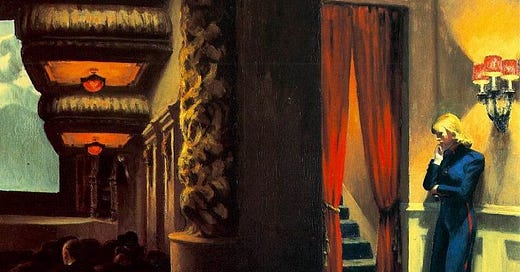



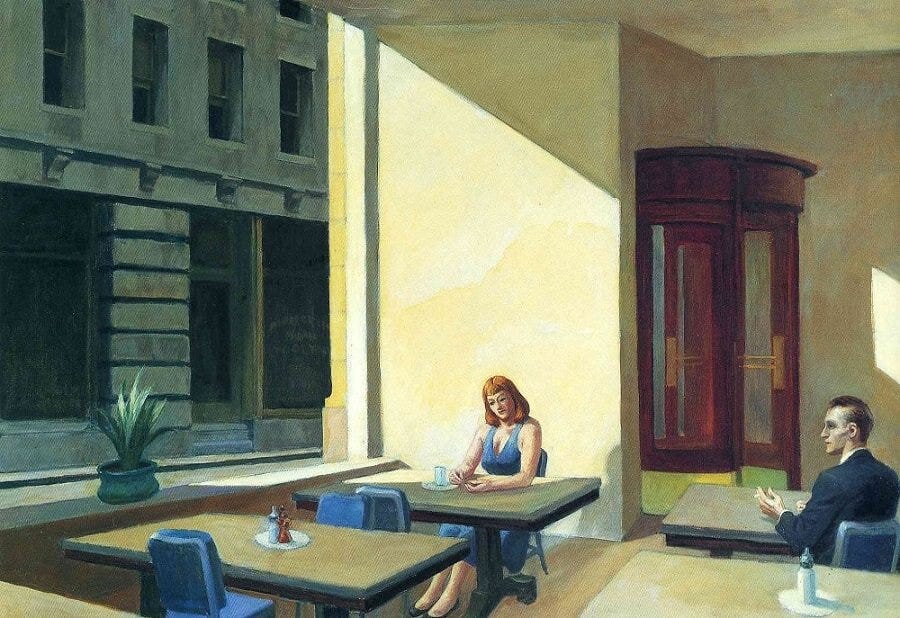

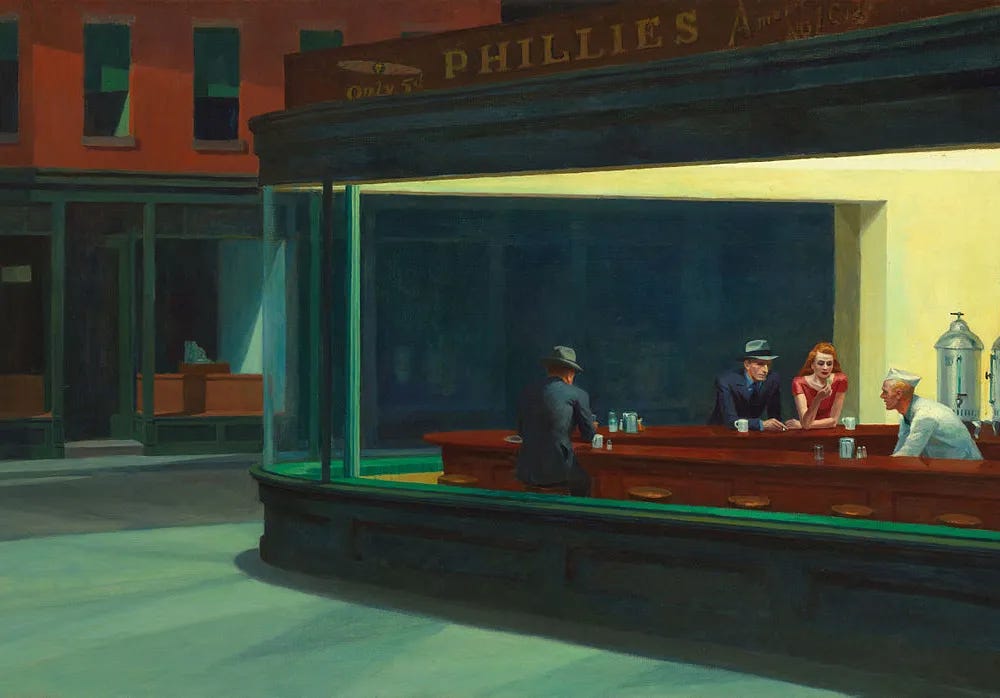
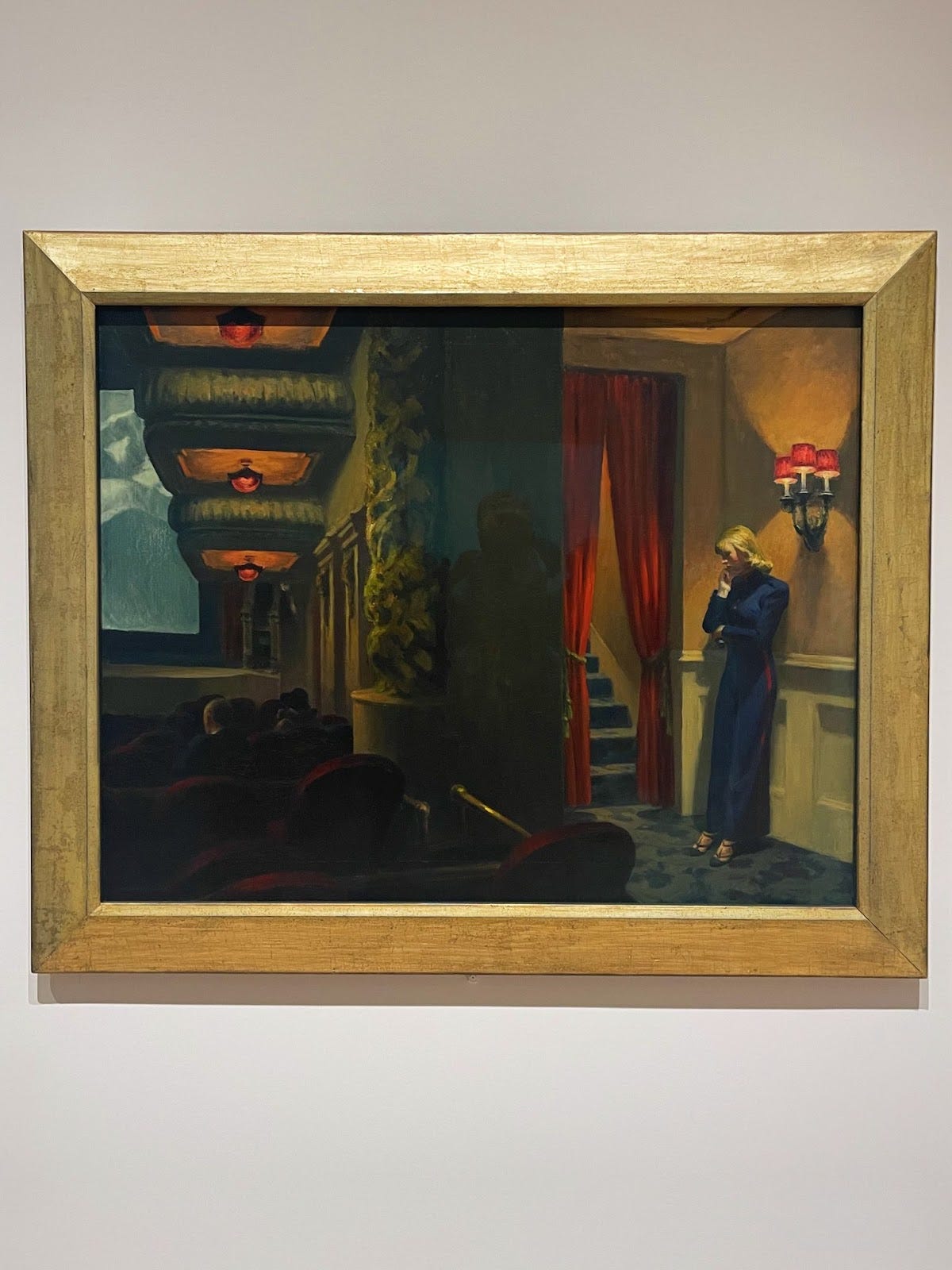
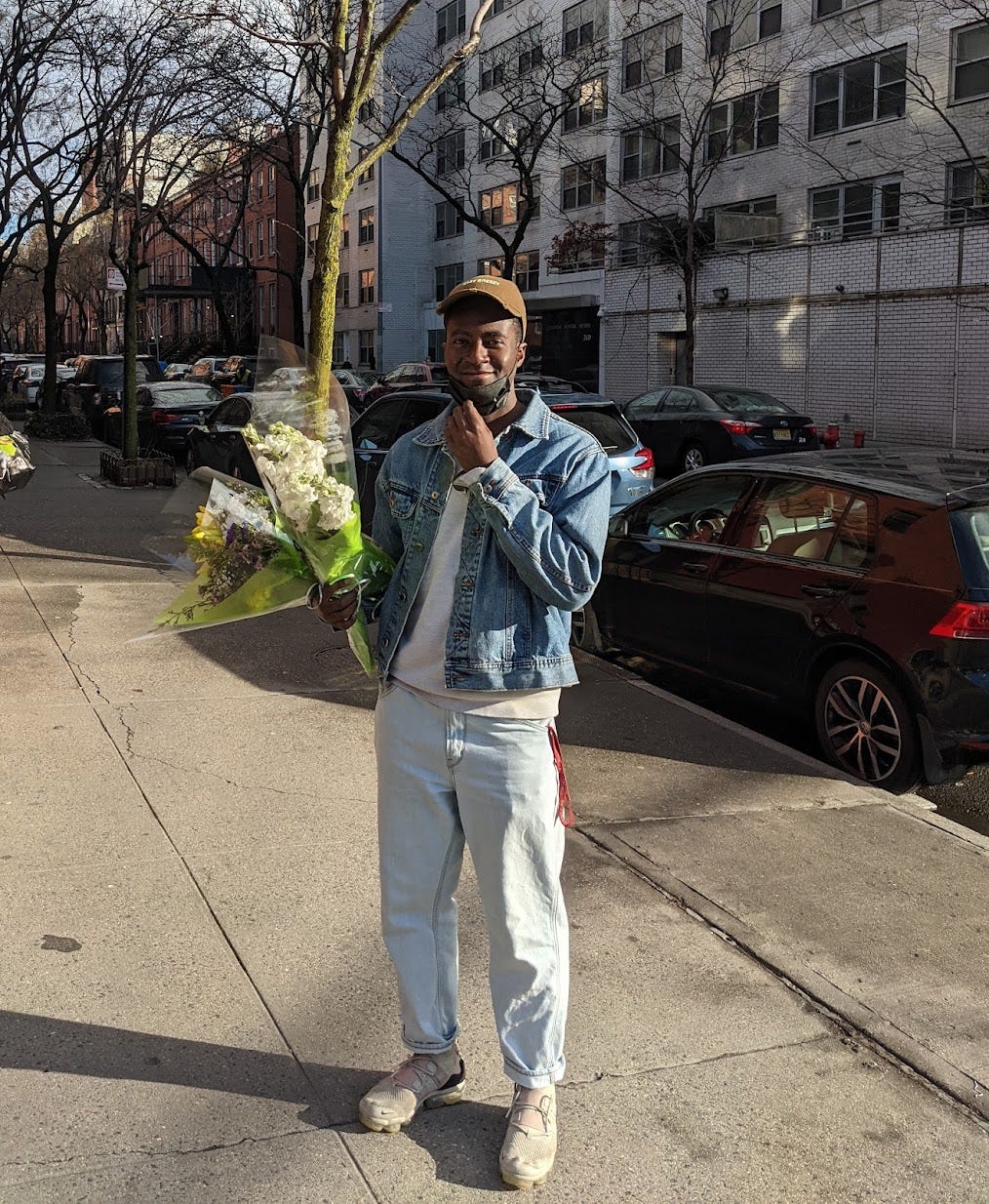

This was great, thank you for sharing it! Coincidentally, I read this 2020 new yorker essay on Hopper and loneliness earlier this week, feels like a nice companion piece: https://www.newyorker.com/magazine/2020/06/08/edward-hopper-and-american-solitude
might need to invest in a print of "new york movie" now